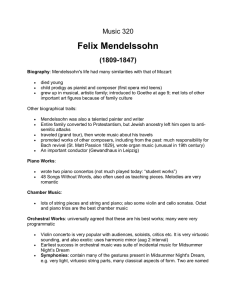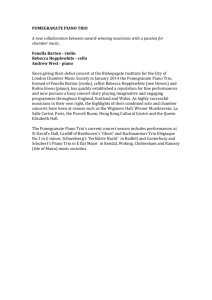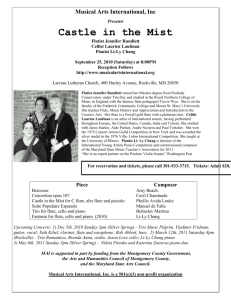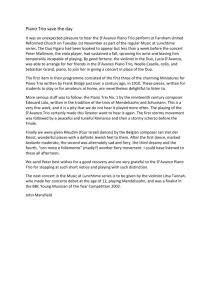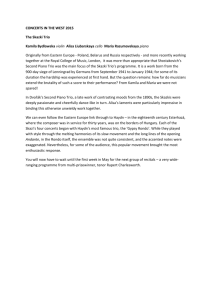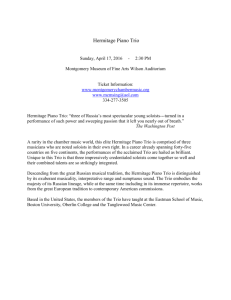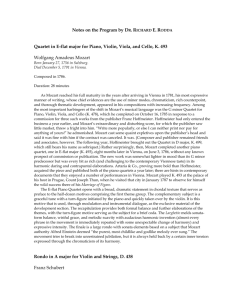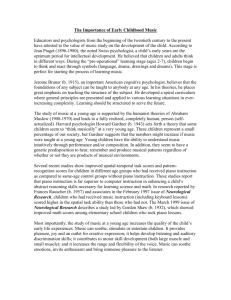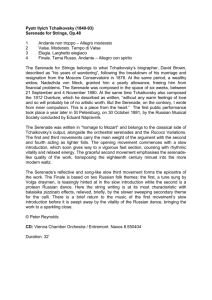a0509-4n
advertisement
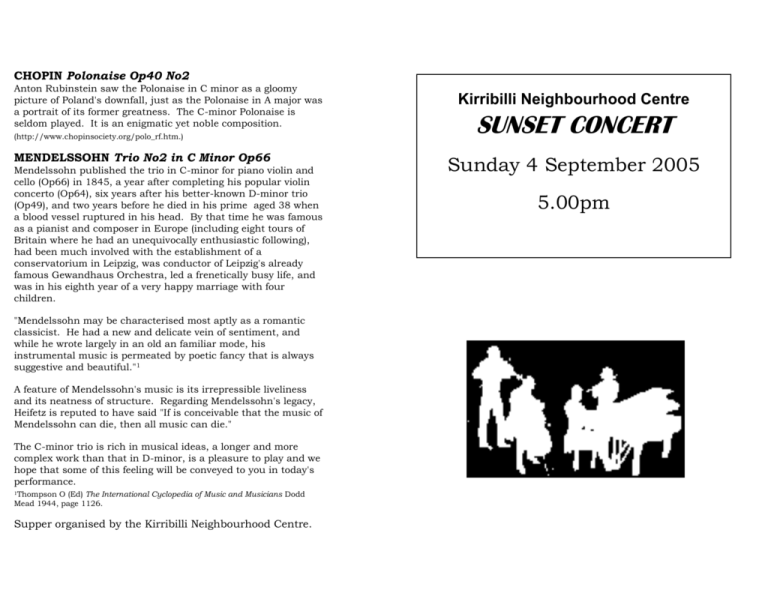
CHOPIN Polonaise Op40 No2 Anton Rubinstein saw the Polonaise in C minor as a gloomy picture of Poland's downfall, just as the Polonaise in A major was a portrait of its former greatness. The C-minor Polonaise is seldom played. It is an enigmatic yet noble composition. (http://www.chopinsociety.org/polo_rf.htm.) MENDELSSOHN Trio No2 in C Minor Op66 Mendelssohn published the trio in C-minor for piano violin and cello (Op66) in 1845, a year after completing his popular violin concerto (Op64), six years after his better-known D-minor trio (Op49), and two years before he died in his prime aged 38 when a blood vessel ruptured in his head. By that time he was famous as a pianist and composer in Europe (including eight tours of Britain where he had an unequivocally enthusiastic following), had been much involved with the establishment of a conservatorium in Leipzig, was conductor of Leipzig's already famous Gewandhaus Orchestra, led a frenetically busy life, and was in his eighth year of a very happy marriage with four children. "Mendelssohn may be characterised most aptly as a romantic classicist. He had a new and delicate vein of sentiment, and while he wrote largely in an old an familiar mode, his instrumental music is permeated by poetic fancy that is always suggestive and beautiful."1 A feature of Mendelssohn's music is its irrepressible liveliness and its neatness of structure. Regarding Mendelssohn's legacy, Heifetz is reputed to have said "If is conceivable that the music of Mendelssohn can die, then all music can die." The C-minor trio is rich in musical ideas, a longer and more complex work than that in D-minor, is a pleasure to play and we hope that some of this feeling will be conveyed to you in today's performance. 1Thompson O (Ed) The International Cyclopedia of Music and Musicians Dodd Mead 1944, page 1126. Supper organised by the Kirribilli Neighbourhood Centre. Kirribilli Neighbourhood Centre SUNSET CONCERT Sunday 4 September 2005 5.00pm AMATEUR CHAMBER MUSIC SOCIETY - Program BRIDGE Miniatures 7-9 7 Valse Russe, 8 Hornpipe, 9 March Murray Brown (piano), George Carrard (violin) Robyn Godfrey (cello) MARTINU Sonata for Flute and Piano Moderato, Adagio, Allegro poco moderato Alex Chervonsky (flute), Halani Lloyd (piano) CHOPIN Polonaise Op40 No2 Nicholas Stokes (piano) Interval MENDELSSOHN Trio No2 in C Minor Op66 Allegro energico e con fuoco, Andante espressivo, Scherzo - molto allegro quasi presto, Finale - Allegro appassionato Murray Brown (piano), George Carrard (violin), Robyn Godfrey (cello) Supper - Program Notes BRIDGE Miniatures Frank Bridge wrote his Nine Miniatures in 1906 when he was 27 years old for two sisters who were friends of his. His talent as a composer has been largely undervalued though his famous pupil Benjamin Britten, who as a young student had occasionally spent months with the Bridges, continued to perform and champion the music of his teacher. Britten credited Bridge with teaching him the discipline necessary for good composition. (netreach.net/~druid/FB/cat1.htm, classical.net/music/comp.lst/acc/bridge.html). MARTINU Sonata for Flute and Piano Born in a mountain village in what is now the Czech Republic, Bohuslav Martinu (1890 - 1959) was a prolific composer as a child, and at age 16 entered Prague Conservatory as a violin student. His interest, however, lay in composition. Failing to complete his course at the Conservatory or at the Prague Organ School, to which he had been transferred, he worked as an orchestral player with the Czech Philharmonic and, at the age of 33, moved to Paris. With the approach of the German armies in 1940 he went to the United States of America, where Koussevitzky encouraged him with commissions. Political events in Czechoslovakia prevented his intended return after the war, and he spent his final years abroad, dying in Switzerland in 1959. Martinu’s father was a shoemaker and part-time fireman. As a child, Martinu assisted his father spotting forest fires from the top of a church tower. James Galway imagines this early experience shows in Martinu's music and writes "So many scale passages slowly descend as if he was climbing down a ladder to get his feet on solid ground at last." Whatever the inspiration, Martinu in this sonata explores to great effect the intricate textures of sonority created between a flute and a piano as equal partners. (www.virginia.edu/music/pressrelease/bethchandler042704.html, www.andrewdarlison.co.uk/notes/mart.htm, http://doodlebug.charleslogan.net/archive/christopherlee/notes.html, http://www.naxos.com/mainsite/default.asp?pn=Composers&char=M&ComposerID=670, http://www.classical-composers.org/html/BohuslavMartinuBrief.html, Galway J Flute p172 Schirmer Books, 1982.)
